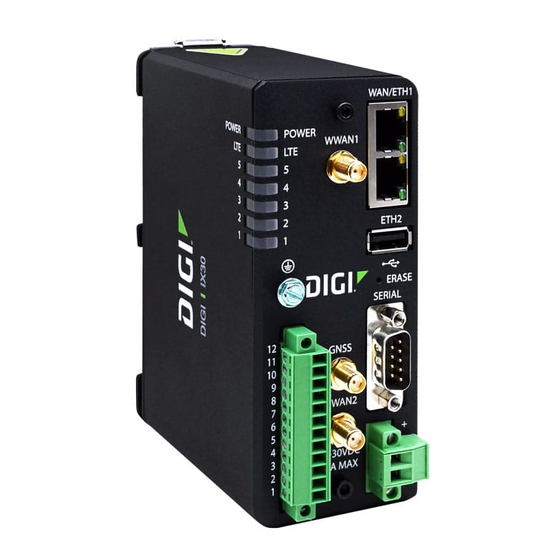
Digi IX30 Manuals
Manuals and User Guides for Digi IX30. We have 1 Digi IX30 manual available for free PDF download: User Manual
Digi IX30 User Manual (1031 pages)
Brand: Digi
|
Category: Network Router
|
Size: 18 MB
Table of Contents
-
IX30 Leds25
-
Power25
-
Lte25
-
SIM Removal37
-
Local Webui39
-
Learn more68
-
Interfaces69
-
Delete a LAN169
-
DHCP Servers171
-
Bridging201
-
Serial Port209
-
Routing274
-
IP Routing275
-
Routing Services301
-
Dynamic DNS306
-
Vrrp311
-
Configure VRRP312
-
Configure VRRP315
-
Ipsec338
-
Ipsec Mode338
-
Ipsec Modes338
-
Authentication339
-
Openvpn393
-
Show GRE Tunnels431
-
L2Tp447
-
L2TP with Ipsec465
-
L2Tpv3 Ethernet467
-
Nemo473
-
Show NEMO Status479
-
Configure DNS512
-
Show DNS Server518
-
WAN Bonding519
-
SNMP Security524
-
Download Mibs529
-
Modbus Gateway561
-
System Time579
-
Python Modules628
-
Local Users710
-
Ldap736
-
Packet Filtering774
-
Web Filtering795
-
Digital Output825
-
Digital Output827
-
Downgrading847
-
Intelliflow888
-
File System906
-
View System Logs921
-
View Event Logs923
-
English960
-
French--Français963
-
Polish--Polskie969
-
Slovak--Slovák971
-
Spanish--Español973
-
The Help Command979
-
Show Config985
-
Show System985
-
Show Network986
-
Analyzer Clear1002
-
Analyzer Save1003
-
Analyzer Start1003
-
Analyzer Stop1003
-
Clear Dhcp-Lease Mac1004
-
Container Create1004
-
Container Delete1004
-
Grep1005
-
Help1005
-
Mkdir1007
-
Modem at1007
-
Modem At-Interactive1007
-
Modem Firmware Check1007
-
Modem Firmware List1007
-
Modem Pin Change1009
-
Modem Pin Disable1009
-
Modem Pin Enable1010
-
Modem Pin Status1010
-
Modem Pin Unlock1010
-
Modem Puk Status1010
-
Modem Puk Unlock1011
-
Modem Reset1011
-
Modem Scan1011
-
Modem Sim-Slot1011
-
Monitoring1012
-
More1012
-
Ping1013
-
Poweroff1013
-
Reboot1013
-
Scp1015
-
Show Analyzer1015
-
Show Arp1015
-
Show Cloud1015
-
Show Config1016
-
Show Containers1016
-
Show Dhcp-Lease1016
-
Show Dns1016
-
Show Eth1016
-
Show Event1017
-
Show Hotspot1017
-
Show Ipsec1017
-
Show L2Tp Lac1017
-
Show L2Tp Lns1018
-
Show L2Tpeth1018
-
Show Location1018
-
Show Log1018
-
Show Manufacture1018
-
Show Modbus-Gateway1019
-
Show Modem1019
-
Show Mqtt1019
-
Show Nemo1019
-
Show Network1020
-
Show Ntp1020
-
Show Openvpn Client1020
-
Show Openvpn Server1020
-
Show Route1021
-
Show Scep-Client1021
-
Show Scripts1021
-
Show Serial1021
-
Show Surelink Ipsec1022
-
Show System1022
-
Show Usb1022
-
Show Version1023
-
Show Vrrp1023
-
Show Web-Filter1023
-
Speedtest1023
-
Ssh1024
-
System Backup1024
-
System Factory-Erase1025
-
System Find-Me1025
-
System Restore1026
-
System Script Start1027
-
System Script Stop1027
-
System Serial Clear1027
-
System Serial Save1027
-
System Serial Show1028
-
System Serial Start1028
-
System Serial Stop1028
-
System Time Set1029
-
System Time Sync1029
-
System Time Test1029
-
Tail1029
-
Telnet1030
-
Traceroute1030
Advertisement
Advertisement
